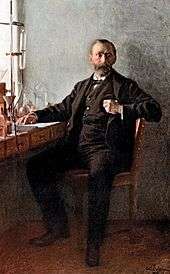Fredrik Ljungström
| Fredrik Ljungström RNO KVO1kl | |
|---|---|
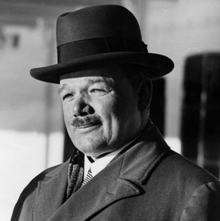 Fredrik Ljungström in Dagens Nyheter. | |
| Born |
16 June 1875 Stockholm, Sweden |
| Died |
18 February 1964 (aged 88) Lidingö, Sweden |
| Nationality | Swedish |
| Education | Östra Real |
| Alma mater | Royal Institute of Technology |
| Occupation |
Engineer Technical designer Industrialist |

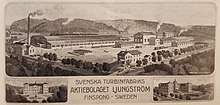
Fredrik Ljungström (16 June 1875 in Stockholm – 18 February 1964 in Stockholm) was a Swedish engineer, technical designer, and industrialist.
Considered one of the foremost inventors of Sweden,[1][2] he accounted for hundreds of innovative technical patents alone, and in collaboration with his brother Birger Ljungström (1872–1948): from early bicycling free wheeling hubs techniques and mechanical automatic transmissions for vehicles, to steam turbines, air preheaters, and circular arc hulls for sailing boats. He co-founded companies such as The New Cycle Company, Ljungström Steam Turbine Co. and Swedish Turbine Manufacturing Co., and associated with other industrialists such as Helge Palmcrantz, Alfred Nobel, Gustaf de Laval, Curt Nicolin, and Gustaf Dalén. As innovative as his ideas were in function, they also often turned out in terms of unconventional external design, such as his steam turbine locomotives and sailboats.
During the resource scarcity of World War II, Fredrik Ljungström's innovative technology for oil shale underground gasification by electrical energy provided a strategical impact for the Swedish Armed Forces.[3] In addition, Ljungström's technology contributed to the first Swedish jet engine, torpedos, and more.
With Fredrik Ljungström's air preheater implemented in a large number of modern power stations around the world until this day with total attributed worldwide fuel savings estimated to 4,960,000,000 tons of oil, "few inventions have been as successful in saving fuel as the Ljungström Air Preheater". In 1995, the Ljungström air preheater was distinguished as the 44th International Historic Mechanical Engineering Landmark by the American Society of Mechanical Engineers.[4] His works are represented nationally in the Swedish National Museum of Science and Technology, the Nordic Museum, and the Swedish Railway Museum, but also internationally such as in the Science Museum of London, England, among others.[5]
Early life and background
Fredrik Ljungström was born in 1875 in Östermalm, Stockholm, to cartographer Jonas Patrik Ljungström, and Amalia (née Falck). His grandfather was the jeweler Johan Patrik Ljungström, his 2nd great grandfather was Protestant reformer Peter Spaak, and his 4th great grandfather early industrialist Abraham Hülphers the Older. In addition, his 2nd great uncle was Johan Börjesson, and his 3rd great uncle Bishop Johan Wingård. Among his siblings were Georg Ljungström, Oscar Ljungström, Birger Ljungström, and among is brothers-in-law George Spaak.
Fredrik Ljungström was married twice. First to Elizabeth (née Waesterberg), daughter of Amanda Sandborg Waesterberg, from whom he was widowed, and secondly to Signe (née Söderberg), daughter of Wilhelm Theodor Söderberg. Among his issue was Gunnar Ljungström, and among his sons-in-law Arthur Lundblom, and Torsten Cassel.
Educated at Östra Real, he attended the Royal Institute of Technology from where he was subsequently conferred an Honorary Doctorate in 1944.
He died in 1964 on Lidingö, and was buried at Norra begravningsplatsen, Stockholm.
Svea Velocipede

The Svea Velocipede was an early invention by Fredrik Ljungström in collaboration with his brothers Birger Ljungström, and Oscar Ljungström. Helge Palmcrantz was also part of the project. An early example in the history of the bicycle, the pedals mechanism of the Svea Velocipede was straight vertical, driven by free wheeling hubs, which was patented by the brothers in 1892.
In connection with Alfred Nobel, the project was further developed and the product sold in a limited quantity of units in Sweden, and the United Kingdom, under the company name The New Cycle Company, to which also George Spaak was connected. Although the general preference for circular pedal mechanisms became clear with time, later bicycle models on the market would adopt its foot-operated bicycle brakes while also employing its free wheeling hubs.
The Svea Velocipede has units represented at the Swedish National Museum of Science and Technology, and the Nordic Museum in Stockholm, Sweden.
Steam turbines

After the Svea Velocipede project, Fredrik and Birger went on to work out a automatic milking device, Beta (1901). It caught the interest of Gustaf Laval at Laval AB Separator. Fredrik was remain leading engineer in this venture until 1908. At the same time, he developed a method for die casting of brass, zinc and aluminium that would be come well-received.
Soon enough, however, it was evident that steam turbines would be the main focus for the brothers' ventures. Early on, Alfred Nobel paid interest also to this endeavour. One project was based on a new type of steam turbine, the Ljungström radial turbine, invented by the brothers and patented by Birger Ljungström in 1894. The invention was installed in a boat model, proucing a speed of 12 knot, making it the then quickest motor boat around Stockholm archipelago. In 1900, a new company was established based on this steam turbine invention, the Ljungström Engine Syndicate Limited in Newcastle, England, where George Spaak was designated CEO.[6] The continued development of the steam turbines was also endorsed by Professor Aurel Stodola.
The turbine principle was furthermore the base for the company ALÅ (Ljungström steam turbine Co.), founded in 1908 in Sweden, that owned all the patents on this revolutionising turbine construction. In 1913 together they founded the separate company STAL (Swedish turbine manufacturing Co.), while the workshop was moved from Stockholm to a factory Finspång, Östergötland. Mechanical engineer Karl Gustaf Karlson, later Professor at Chalmers University of Technology, was connected to the development. This company handled the manufacturing and sales of complete steam turbine driven electric generators. The turbine provided a 10% higher thermodynamic efficiency than previously constructions, in addition to being more compact, requiring less space. STAL:s solutions proved successful, and with contracts such as with Siemens and General Electric, its activities expanded into Europe and beyond. For instance, tt remained in service in the London Underground for 50 years.
It has been said that Ljungström's insights in the steam power came to him already as a child at home, observing how cuisine was prepared in the kitchen.
STAL was acquired by ASEA in 1916 as they wished to market complete packages with turbine driven electric generators. The brothers then left the company but kept control over the all the patents and manufacturing licenses for the Ljungström steam turbines within the company ALÅ.
The technical solutions developed by the brothers at STAL remain employed over the world with significant present-day fuel savings results, including in nuclear power plants.
Steam turbine locomotives

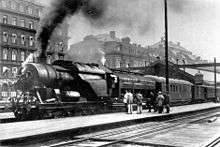
The brothers also designed a number of steam turbine locomotives, some of which were highly successful, starting in 1917. A factory was set up for the purpose in Gåshaga, Lidingö, Stockholm, in 1918, where the Ljungström brothers also worked out the Ljungström heat exchanger for their locomotives.
The first attempt in 1921 was a rather odd-looking machine. Its three driving axles were located under the tender, and the cab and boiler sat on unpowered wheels. Later they changed this design with driving wheels on both the boiler carriage and the tender with separate turbines. The second design was a 2-8-0 similar to a successful freight design. In 1930, the 2000th unit, a Ljungström locomotive, was rolled out of the factory of Nydqvist & Holm AB: TGOJ M3 47, M3t 71.[7] Built from 1930 to 1936 by Nydqvist & Holm, these locomotives replaced conventional ones on the Grängesberg-Oxelösund Railway. No condenser was fitted, as its complexity outweighed its thermodynamic advantages. The wheels were driven by a jackshaft. These engines were not retired until the 1950s when the line was electrified.
The Ljungström locomotives also gained international attention. In England, Beyer, Peacock and Company had license construction of a copy of the Swedish Railways turbine locomotive SJ Littera Å, employed in London, Midland and Scottish Railway.[8][9] Yet another one was delivered to Argentina, designated for the 800 km long distance between Tucumán and Santa Fe, largely through desert with limited water access, needs to which the Ljungström system was especially fitted. The locomotive remained in service until its disappearance during the Argentine Revolution (1966-1973).
Three engines of this type were built, all of which have been preserved. Two units (71 and 73) are exhibited by the Railway Museum of Grängesberg, and the third (72) by the Swedish Railway Museum. The one in Grängesberg is the world's only remaining steam turbine locomotive in function, Ljungström M3t nr 71, manufactured in 1930 by Nydqvist & Holm AB and renovated by the Locomotive Museum for the 125th anniversary of the Swedish Railways in June 1981.[10] With a power of 22 tons, it is still Sweden's most powerful steam locomotive in funcion: practical tests showed that it was able to transport 2,000 tons in 17 per mille elevation.[11]
Air preheaters
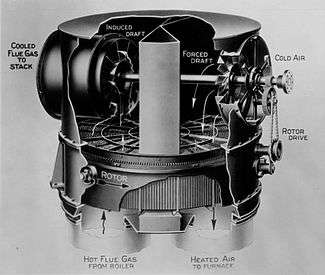

Fredrik Lindström also invented an efficient air preheater, which even in a modern utility boiler provides up to 20 percent of the total heat transfer in the boiler process, but only represents 2 percent of the investment.[12] This innovation was also a result of the factory in Lidingö, with patent achieved in 1930,[13] although an anecdote traces the inception to an air conditioning concern during a visit in the smoky premises of the Royal Swedish Opera in Stockholm.
The factory and workshop activities and laboratories in Lidingö would remain throughout the 1920s, with some 70 personnel. In the 1930s it was used a film studio, and was finally demolished in the 1970s to give space for new industry premises.
ASEA acquired a majority of the company in 1916, and Erik Sundbllad was designated CEO. Royalties were ceased in 1944.
In 1995, it was estimated that the Ljungström air preheater had sold in 10,000s of units for in total some 20 billion dollars.
Shale oil extraction
During the resource scarcity of World War II, Fredrik Ljungström's innovative technology for shale oil extraction underground gasification by electrical energy, called the Ljungström method by which the Ljungström fields are named in Stockholm,[14] provided a significant strategical impact for the Royal Swedish Navy and Air Force.[15] Ljungström obtained his last patent in this industry in 1954. The Ljungström fields, inactived after the war, can be reactivated again in a situation of a need of domestic oil source.
Naval engineering
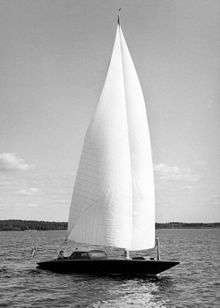
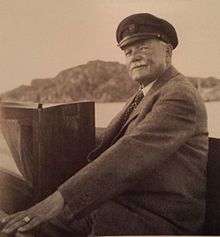
Fredrik Ljungström, an enthusiastic sailor and keen member of the Royal Swedish Yacht Club, made several inventions out of new ideas related to sailing boats. The Ljungström sailboat with the circular arc hull and the Ljungström rig, without a boom and double sail that can work as a spinnaker, is named after Fredrik Ljungström.[16] The history of the productions are represented at the Maritime Museum in Stockholm.[17] He also experimented with a vibrationless yacht motor.
Other ventures
The transmission technology Spontan, developed by Fredrik Ljungström in the 1920s, attracted attention on the Swedish market, and several private cars were equipped with the system with positive results. Chrysler in the United States got involved, but shortly afterwards had to retreat due to the Wall Street Crash of 1929 and the subsequent Great Depression.
Although initially interested in aerospace engineering - Fredrik drafted a flight machine project late 19th century - applied aerodynamics never competeted among his main subjects of interest, especially after having lost his son and pilot Lieutenant Einar Ljungström in an airplane crash in 1927. Yet, after Word War II, Ljungström's technology contributed to the first Swedish jet engine, with STAL Dovern based in part on his technology, developed by the company he founded.
Fredrik Ljungström become a well-reputed figure in the 20th technical industry in Sweden. Together with his fellow at Royal Swedish Academy of Engineering Sciences Gustaf Dalén, the two inventors once came late to a meeting at the Gustaf Dalén, going around town in their coach in enthusiasm discussing new ideas. Curt Nicolin spoke well about him in a book about him Nobelmiddag.
The works of Fredrik Ljungström are represented in the Swedish National Museum of Science and Technology, the Nordic Museum, the Swedish Railway Museum, the Maritime Museum, the Nobel Museum, and the Lidingö Museum, among others.
Image gallery

.jpg) Ljungström locomotive from the Wonder Book of Engineering Wonders (1931).
Ljungström locomotive from the Wonder Book of Engineering Wonders (1931).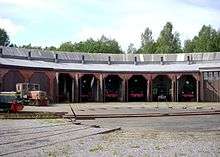 Ljungström locomotives stationed at Railway Museum of Grängesberg.
Ljungström locomotives stationed at Railway Museum of Grängesberg. Ljungström system equipped turbine locomotive M3t nr 71 at the Railway Museum of Grängesberg.
Ljungström system equipped turbine locomotive M3t nr 71 at the Railway Museum of Grängesberg.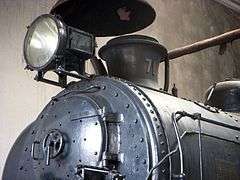 Details on M3t nr 71.
Details on M3t nr 71. Detail: Turbinlokomotiv System Ljungström.
Detail: Turbinlokomotiv System Ljungström. STAL turbine generator (1932).
STAL turbine generator (1932). STAL turbine generator (1947).
STAL turbine generator (1947).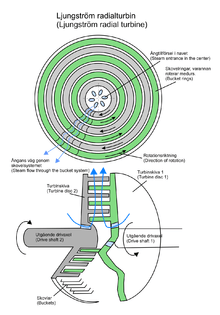 Ljungström radial turbine.
Ljungström radial turbine. Main patent drawings for Ljungström heat exchanger, USPTO No. 1746598, 1930.
Main patent drawings for Ljungström heat exchanger, USPTO No. 1746598, 1930. Ljungström Spontan Drive system (1928).
Ljungström Spontan Drive system (1928).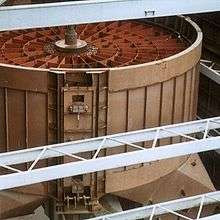 Ljungström air preheater in modern application (2010).
Ljungström air preheater in modern application (2010).
Bibliography
- Studie över fartyg med formen bestämd av cirkelbågar och dess tillämpning på segelbärande motrofartyg och passagerarfartyg, Stockholm, Sveriges standardiseringskommission, 1952
- Unda Maris 1947-48. Tema: Nordisk fiskebåtbyggarekongress 1947, Sjöfartsmuseet, 1948
- Cirkelbågsskrov (Segel och motor), 1939: nr. 5-8, 25 s
- Ljungströms luftförvärmare: Föredrag, hållet vid Föreningens för kraft- och bränsleekonomi årsmöte i Helsingfors den 27 April 1923, Helsingfors, 1923
- Ljungströms turbinlokomotiv, Stockholm, 1922
- The Development of the Ljungström Steam Turbine and Air Preheater by Dr. Fredrik Ljungström, Proceedings of the Institution of Mechanical Engineers, volume 160, issue 1 (1 June 1949)
Distinctions
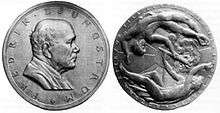
Orders



Academic


Awards








- Silver medal of the World Exposition for the Svea Velocopede
Fellowships





Eponyms






References
- ↑ http://www.tekniskamuseet.se/1/1889.html
- ↑ https://sites.google.com/site/ljungstromare/home
- ↑ https://sok.riksarkivet.se/sbl/Presentation.aspx?id=9630
- ↑ https://www.asme.org/getmedia/c7cf3d83-508f-4946-b476-9399c390fc83/185-Ljungstrom-Air-Preheater.aspx
- ↑ http://sit-ab.leon.se/
- ↑ http://runeberg.org/vemindu/0483.html
- ↑ http://www.historiskt.nu/rullande/turbinlok/turbinl_utv.html
- ↑ http://www.railwaywondersoftheworld.com/ljungstrom.html
- ↑ http://www.douglas-self.com/MUSEUM/LOCOLOCO/ljung/ljungstr.htm
- ↑ Information enligt Lokmuseet i Grängesberg
- ↑ Archived 2007-09-23 at the Wayback Machine.
- ↑ "The Ljungström Air Preheater 1920. An International Historic Mechanical Engineering Landmark" (PDF) (PDF). Svenska Mekanisters Riksförening; American Society of Mechanical Engineers. Retrieved 2009-01-10.
- ↑ Patent USPTO No. 1746598, 11 February 1930
- ↑ http://www.kumlagk.se/klubb/omradeshistoria/
- ↑ https://sok.riksarkivet.se/sbl/Presentation.aspx?id=9630
- ↑ https://sites.google.com/site/ljungstromare/links/yachting-1977
- ↑ http://digitaltmuseum.se/011024679896?page=5&query=fredrik%20ljungstr%C3%B6m&pos=113
- ↑ Samtliga pristagare Archived 2009-12-06 at the Wayback Machine. kth.se, retrieved on 2009-02-05
- ↑ James Watt International Medal Recipients Archived 2009-03-19 at the Wayback Machine. imeche.org, retrieved on 2009-02-05
- ↑ Svenska Dagbladet 19 March 1950, p. 3
- ↑ http://www.finspangsslott.se/eng/hotel/1910-birger-and-fredrik-ljungstrom
Literature
- Pionjärer vid ritbordet, Enskede: Båt & skärgård, 2000, ISBN 91-970902-6-3
- Fredrik Ljungström 1875-1964 Uppfinnare och inspiratör (1999) by Olof Ljungström, Sveriges Mekanisters Riksförening, ISBN 91-630-7639-X
- När uppfinnarna var tidens hjältar (1994), Populär historia, Lund (1991), Börje Isakson, ISSN 1102-0822; 1994:5, s. 48-51
- Svenska snilleblixtar, Isakson, Börje, 1939- (författare) Johansson, George, Stockholm : Natur och kultur, 1994, ISBN 91-27-03899-8
- Birger and Fredrik Ljungström - inventors (1955) by Sven A. Hansson (1907-1996)
External links
| Wikimedia Commons has media related to Fredrik Ljungström. |
- Biography at the Swedish National Museum of Science and Technology website
- STAL company page at the Swedish National Museum of Science and Technology website
- Photo collection of Ljungström steam turbine locomotives at the Railway Museum of Grängesberg
- Utvecklingen av Ljungströms ångturbin och luftförvärmare, Tekn. dr Fredrik Ljungström, Fiskebäckskil
- Ljungström Prize of the Swedish National Mechanics' Association (sv)
- SRM 100 year jubilee, the story about the Ljungström brothers
- Free Patents Online: Fredrik Ljungstrom
- LJUNGSTRÖM Corporate website
- Pupulär Historia (Swedish)
- (Swedish)
